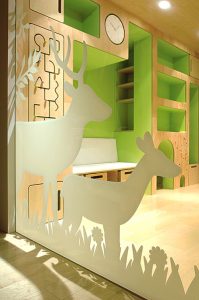
By Rebecca Calbert, AIA, LEED AP, NCARB
As an architect, I notice my surroundings more than the “average bear.”
And lately, trends in youth ministry interior design bring to mind Goldilocks and the Three Bears. Some spaces are too hot, some are too cold, and some are just right.
I’ve seen church facilities take a Disney-esque approach. Taken to extremes, that’s “too hot.” (After all, if church looks like Disneyland, what makes Disneyland special anymore?)
I’ve also seen churches go in the opposite direction — far more puritan. Some treat children’s spaces no differently than the rest of the facility, with stark, white hallways that are more sterile than modern-day public schools.
To get to “just right,” every church should look to its mission and community. If your mission is focused on children and young families, then your church is all about kids and celebrating the child.
The goal, then, is to make church so fun that children beg to come back. Here’s how.
 The right mix: 5 proven strategies
The right mix: 5 proven strategies
#1: Start small (and ask for help)
It’s easy to become frozen by all the available choices, so consider breaking down the decisions into smaller bites. Painting a light neutral color, adding a little decorative trim, and freshening up the carpet is easily within reach.
But, if you don’t feel comfortable making material and color selections, enlist the help of a church member who you believe personifies your community.
#2: Know when to ask for more help!
On the other end of the spectrum, a complete design (or redesign) — while exciting — can be

overwhelming. Plan for large-scale decisions to be made by the church design committee. Then, allow for stakeholders to speak to their very different needs for the space.
Youth ministers will prioritize ease of supervision, aesthetics, and welcoming entry and common areas.
Teachers will want easy-to-clean surfaces, lots of storage, and sound-absorbing acoustics. If your space will have hard walls and ceilings, introduce carpets and fabrics to help absorb the sound. To that end, also, consider area rugs instead of wall-to-wall carpeting.
Parents will be concerned with ease of drop-off and security.
And children themselves, of course, can offer creative ideas.
 #3: Think like a kid
#3: Think like a kid
It sounds obvious, but remember that children are small. Sit down on the floor and look around at the environment, from a child’s perspective, with a critical eye.
Mount pictures and handouts children would find interesting at their eye level.
Keep the room bright and airy, using colors that will help to make the space comfortable. Or, use pastels with small pops of bolder colors.
Children who are too young to read need non-verbal cues to help them navigate the space. Include changes of color, and add simple, bright graphics — again, at children’s eye level — to help them know they’re in the right place.
Finally, keep in mind that toddlers will give very little notice when they need to use the restroom; so, think about proximity. Also incorporate child-size restroom equipment — small toilets, as well as sinks mounted low so kids can easily wash hands without the risk of falling off a step stool.
 #4: Whatever you do, stay versatile
#4: Whatever you do, stay versatile
Think about it — do you know a single 10-year-old who likes the same things he did at 5? Today’s Fidget Spinners will quickly become tomorrow’s Tickle Me Elmo.
Don’t build more today than you can afford to demolish in five years, when your congregation has grown so much that you are moving the children’s ministry into a completely new wing.
As the old adage goes, the only constant is change — and the congregation (young and old) is always growing and changing.
#5: The message drives the magic
No amount of kid-friendly aesthetics can be successful without the right message behind it. Above all, you must communicate to children that they belong. This is true whether you’re building a completely new youth ministry wing from scratch, or renovating an existing space to make it more appealing.
Rebecca Calbert, AIA, LEED AP, NCARB is the Owner and Principal Architect at Calbert Design Group, LLC in Kennesaw, Ga. With 30 years of professional experience, Calbert has worked with various award-winning architectural firms in the Metro Atlanta area.


